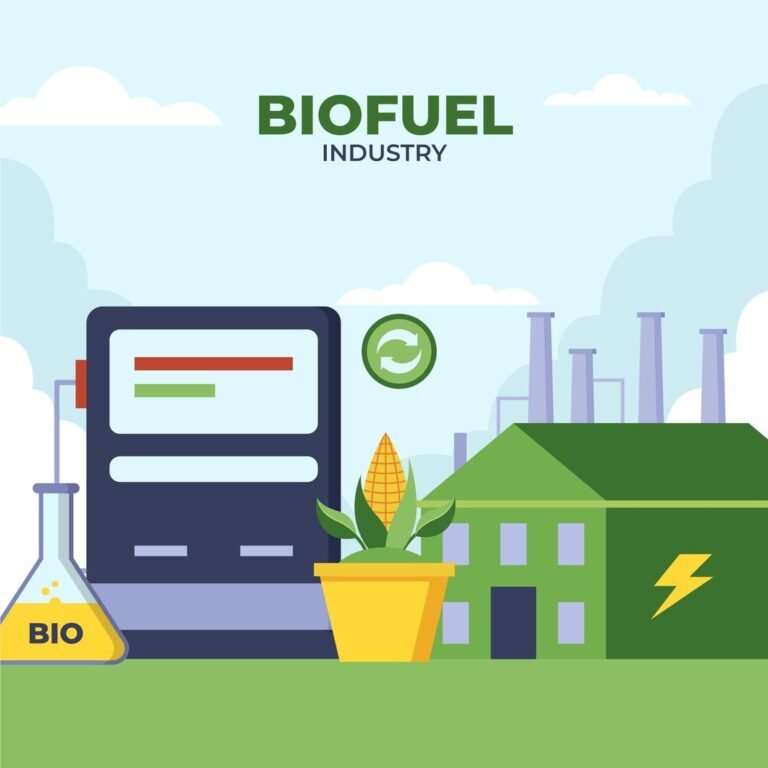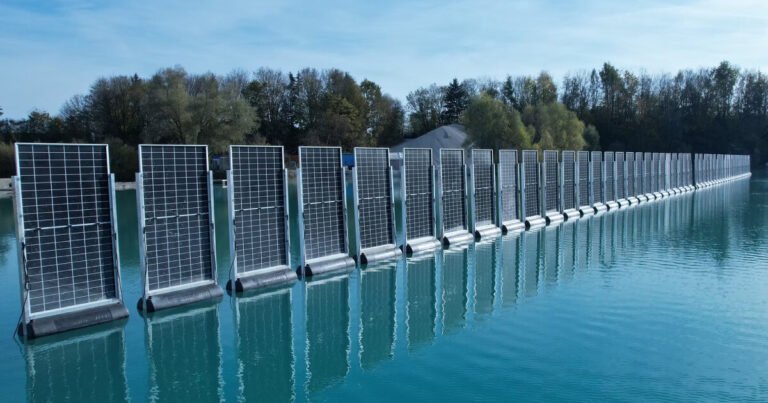What Is Sustainable Fuel? Examples, Uses, and Environmental Impact
In 2023, a Norwegian airline made headlines by offsetting 100 domestic flights’ fuel use with sustainable aviation fuel, cutting carbon emissions by up to 80% compared to traditional jet fuel. This wasn’t a futuristic concept; it was a glimpse into what’s already possible when innovation meets urgency.
As we face rising temperatures and shrinking natural resources, sustainable fuels have become a vital solution. Unlike fossil fuels, tied to a history of environmental harm, sustainable fuels open the door to a cleaner, low-carbon future. From algae-based biodiesel to hydrogen harvested from renewable energy, these alternatives are transforming industries that once seemed impossible to decarbonise. Yet the shift is more than just technological—it’s a necessary evolution for our economies, ecosystems, and way of life.

In This Article
- What Is Sustainable Fuel?
- Examples of Sustainable Fuels
- Uses of Sustainable Fuels Across Sectors
- Environmental Impact: Benefits and Concerns
- How to Support the Shift to Sustainable Fuel
- Conclusion:
What Is Sustainable Fuel?
Sustainable fuel is energy we can rely on without harming the planet. Unlike fossil fuels, which take millions of years to form, sustainable fuels are made from resources that naturally replenish in a short time. These include biofuels from plants, hydrogen, and synthetic fuels created using renewable energy.
What makes these fuels special is their potential to reduce greenhouse gas emissions. For example, the U.S. Environmental Protection Agency (EPA) notes that certain biofuels can significantly lower emissions compared to traditional gasoline. Similarly, hydrogen produced from renewable sources emits only water vapour when used, offering a clean energy alternative.
The International Energy Agency (IEA) emphasises that to meet global climate goals, the use of low-emission fuels like biofuels and hydrogen needs to double by 2030 and double again by 2050. This shift is crucial for sectors like transportation and industry, where reducing emissions is particularly challenging
Incorporating sustainable fuels into our energy mix isn’t just about the environment; it’s also about energy security and economic resilience. By investing in these alternatives, we can reduce our dependence on imported oil and create new job opportunities in emerging energy sectors.
Examples of Sustainable Fuels
1. Biofuels: Ethanol and Biodiesel
Biofuels like ethanol and biodiesel are derived from organic materials. Ethanol is typically produced by fermenting sugars from crops such as corn and sugarcane, while biodiesel is made from vegetable oils, animal fats, or recycled cooking grease. These fuels can be blended with traditional petroleum-based fuels to reduce greenhouse gas emissions. For instance, E85 is a common blend consisting of 85% ethanol and 15% gasoline.
Pros:
- Compatible with existing engine technologies.
- Helps decrease reliance on imported oil.
Cons:
- Production can lead to deforestation.
- May compete with food production, affecting food prices and availability.
According to the EPA, the Renewable Fuel Standard program has set increasing targets for biofuel usage, aiming to enhance energy security and reduce greenhouse gas emissions.
2. Biogas
Biogas is produced through the anaerobic digestion of organic waste, such as agricultural residues, manure, and food waste. This process generates a mixture primarily composed of methane and carbon dioxide. After purification, biogas can be used for heating, electricity generation, or as a vehicle fuel.
Pros:
- Utilises waste materials, reducing landfill usage.
- Produces a nutrient-rich byproduct called digestate, which can be used as fertiliser.
Cons:
- Requires significant infrastructure for collection and processing.
- Methane leaks during production can offset environmental benefits if not properly managed.
The American Biogas Council highlights that biogas can be a versatile energy source, contributing to waste management and renewable energy goals.
3. Hydrogen
Hydrogen fuel cells generate electricity by combining hydrogen with oxygen, emitting only water vapour as a byproduct. When hydrogen is produced via electrolysis using renewable energy sources (known as green hydrogen), the process is carbon-neutral.
Pros:
- Zero emissions at the point of use.
- High energy density, suitable for heavy-duty transportation and industrial applications (Evro et al., 2024)
Cons:
- Production of green hydrogen is currently expensive and energy-intensive.
- Requires the development of new infrastructure for storage and distribution.
The U.S. Department of Energy is investing in reducing the cost of green hydrogen production, aiming to make it a more viable and widespread energy solution.
4. Algae-Based Fuels
Algae can be cultivated to produce oil-rich biomass, which is then converted into biodiesel. According to a study, unlike traditional biofuel crops, algae do not compete with food crops for arable land and can be grown in various environments, including wastewater.
Pros:
- High yield per acre compared to traditional crops, according to the Massachusetts Institute of Technology (MIT).
- Can utilise non-arable land and saline water, reducing competition with agriculture.
Cons:
- Currently, production costs are high, limiting commercial viability.
- Scaling up production to meet energy demands poses technical challenges.
Research indicates that advancements in cultivation and processing technologies are essential to make algae-based fuels a competitive alternative.
5. Synthetic E-Fuels
Synthetic e-fuels are created by combining captured carbon dioxide with green hydrogen, resulting in fuels that mimic traditional hydrocarbons but with net-zero emissions. These fuels can be used in existing engines and infrastructure, offering a transitional solution toward decarbonization.
Pros:
- Compatible with current fuel distribution systems and engines.
- Potential to achieve carbon neutrality when produced with renewable energy.
Cons:
- Production is currently energy-intensive and costly.
- Availability of captured CO₂ and green hydrogen is limited.
Studies suggest that while synthetic e-fuels hold promise, significant investments in renewable energy and carbon capture technologies are necessary to realise their full potential.
Uses of Sustainable Fuels Across Sectors
Transportation
Road Transport: Countries like the United States and Brazil have been pioneers in integrating biofuels into their transportation systems. In Brazil, for instance, ethanol derived from sugarcane is blended into gasoline at rates up to 27%, a practice that has been in place since 2015. Similarly, the U.S. incorporates bioethanol and biodiesel into its fuel supply, reducing reliance on fossil fuels and lowering greenhouse gas emissions.
Aviation: The aviation industry is making significant strides with Sustainable Aviation Fuel (SAF). A report by The Wall Street Journal states that United Airlines has invested in innovative technologies to produce SAF from carbon dioxide and water, aiming for net-zero emissions by 2050. Air France-KLM has also committed to purchasing up to 25 million gallons of SAF annually starting in 2029, aligning with their goal of incorporating 10% SAF by 2030.
Maritime Shipping: Shipping giants like Maersk are leading the charge in maritime decarbonization. Maersk’s vessel, the Ane Maersk, recently completed its maiden voyage powered entirely by green methanol, marking a significant milestone in sustainable shipping. The company has ambitious plans to expand its fleet of methanol-powered ships, aiming for net-zero emissions by 2040.
Electricity Generation
Biogas in Rural India: In rural India, biogas plants are transforming lives by providing clean electricity to thousands of homes. These plants utilise organic waste, such as cow dung, to produce biogas, which can be used for cooking, lighting, and even powering diesel engines. This not only reduces dependence on coal but also improves indoor air quality and health outcomes.
Biomass Power in the UK: The United Kingdom has embraced biomass energy as a renewable source of electricity. Facilities like the Drax Power Station have transitioned from coal to sustainably sourced wood pellets, contributing significantly to the national grid. However, recent analyses suggest that the UK could meet its energy goals without relying heavily on biomass by investing more in wind power and smart energy solutions.
Industrial Use
Hydrogen in Steel Production: The steel industry, traditionally a significant emitter of CO₂, is undergoing a green transformation. In Sweden, the HYBRIT project is pioneering the use of hydrogen to produce fossil-free steel. By replacing coal with hydrogen in the steelmaking process, HYBRIT aims to reduce Sweden’s total carbon dioxide emissions by at least 10%. This groundbreaking initiative has already produced over 5,000 tonnes of hydrogen-reduced iron, with companies like Volvo incorporating it into their products
Domestic Use
Biogas for Cooking in Kenya: In Kenya, biogas digesters are making a significant impact on rural households. By converting animal waste into biogas, families can cook without relying on wood or charcoal, reducing indoor air pollution and deforestation. The Kenya Biogas Programme has been instrumental in providing these systems, improving the quality of life for many, and contributing to environmental conservation.
Environmental Impact: Benefits and Concerns
Benefits
1. Lower Greenhouse Gas Emissions
One of the primary advantages of sustainable fuels is their potential to reduce greenhouse gas emissions. For instance, biodiesel can significantly lower emissions compared to petroleum diesel. According to the U.S. Department of Energy, using biodiesel can reduce lifecycle greenhouse gas emissions by up to 86% compared to conventional diesel. This reduction plays a crucial role in mitigating climate change and improving air quality.
2. Utilisation of Waste Products
Sustainable fuels often make use of waste materials, turning potential pollutants into valuable energy sources. For example, converting used cooking oil into biodiesel not only provides a renewable fuel but also reduces the amount of waste sent to landfills. This approach helps in managing waste effectively and reduces methane emissions from decomposing organic matter.
3. Enhanced Energy Security
By diversifying energy sources, sustainable fuels can reduce dependence on imported fossil fuels. This diversification enhances national energy security and can lead to more stable energy prices. Countries investing in domestic biofuel production can insulate themselves from global oil market fluctuations.
4. Job Creation
The sustainable fuel industry has become a significant source of employment. According to the International Renewable Energy Agency (IRENA), the global biofuel sector employed approximately 2.8 million people in 2023. These jobs span various areas, including agriculture, processing, and distribution, contributing to economic development, especially in rural regions.
Concerns
1. Land Use Conflicts
The cultivation of biofuel crops can sometimes compete with food production, raising concerns about food security. Allocating large areas of land for energy crops may displace food crops, potentially driving up food prices and reducing availability. For example, the expansion of biofuel plantations in Indonesia has been linked to deforestation and the displacement of indigenous communities. Such land-use changes can have significant social and environmental consequences.
2. Water Consumption
Producing biofuels, particularly bioethanol and biodiesel, can be water-intensive. The water required for growing feedstock crops and processing them into fuel can strain local water resources, especially in arid regions. A study published by the EPA highlights that increased biofuel production could lead to higher water usage, impacting water availability for other uses.
3. Emissions from Production Processes
While the end-use of sustainable fuels tends to be cleaner, the production processes can generate emissions if not managed properly. For instance, the energy used in cultivating crops, transporting feedstocks, and processing fuels can contribute to greenhouse gas emissions. Ensuring that these processes utilise renewable energy sources and efficient technologies is crucial to maximising the environmental benefits of sustainable fuels.
How to Support the Shift to Sustainable Fuel
1. Advocate for Smart Policies
Government policies play a crucial role in accelerating the adoption of sustainable fuels. The EPA has set ambitious renewable fuel targets for 2023–2025, aiming to reduce reliance on fossil fuels and enhance energy security. Additionally, the Clean Fuel Production Credit (§45Z), effective from 2025, offers tax incentives to producers based on the carbon intensity of their fuels.
By supporting such initiatives and urging elected officials to prioritise clean energy policies, we can create a more favourable environment for sustainable fuel development.
2. Make Informed Consumer Choices
As consumers, our choices can drive demand for sustainable fuels. Airlines are increasingly investing in sustainable aviation fuels (SAFs) to reduce their carbon footprints. For instance, Air New Zealand has signed an agreement to purchase nine million litres of SAF from Neste, marking its largest SAF deal to date. The fuel, produced at Neste’s Singapore refinery, is expected to reduce carbon emissions by up to 80% over its lifecycle compared to conventional jet fuel.
When booking flights or choosing transportation services, consider companies that prioritise sustainability. Your support encourages more businesses to adopt eco-friendly practices.
3. Encourage Corporate Responsibility
Businesses can significantly impact the transition to sustainable fuels by updating their fleets and energy systems. Many companies are now investing in alternative fuel vehicles (AFVs) and exploring renewable diesel options to reduce emissions.
If you’re part of a company, advocate for sustainable practices and highlight the long-term benefits of eco-friendly investments. Engaging with suppliers and partners who prioritise sustainability can also amplify your impact.
4. Support Community Initiatives
Local projects play a vital role in promoting sustainable fuels. According to the American Biogas Council, in 2024, the U.S. saw a record investment of over $3 billion in biogas systems, with 125 new projects coming online. These initiatives not only reduce greenhouse gas emissions but also create jobs and support local economies.
Participating in or supporting local biogas and biodiesel projects can make a tangible difference. Whether it’s through volunteering, investing, or simply spreading the word, community involvement is key to driving change.
Learn More: Fossil Fuels Examples in Daily Life
Conclusion:
The transition to sustainable fuels isn’t just about science and policy—it’s about people, choices, and collective responsibility. Whether you’re a policymaker, business leader, or a concerned citizen, your actions can help scale the adoption of sustainable fuels. As the world hurtles toward an uncertain climate future, sustainable fuels offer a bridge to a cleaner, more resilient energy system.
Actionable Tips:
- Switch to E10 or B20 if available in your region
- Support businesses using sustainable logistics
- Advocate for local biodiesel or biogas initiatives
- Install a home biodigester if you have access to organic waste







